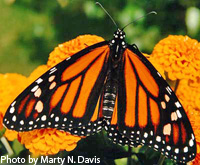
| Monarch Butterflies Do Not Arrive in Mexico | 13 December 13 |

Although monarch butterfly populations have fluctuated, the trend over the past decade has been one of a steady and alarming decline. 2012's record low numbers of roughly 60 million migrant butterflies has been shattered by the pitiful three million that made it to Mexico this year. The dramatic drop in monarch numbers unfortunately reflects similar trends in other insect populations, most notably the wild bee. Bee declines have been linked to use of pesticides containing neonicotinoids, a chemical that greatly weakens bees' immune systems. However, many experts say that this is but one of many overarching, widespread problems, such as mass habitat loss, the use of many destructive chemicals, and disease. Native plants and trees play irreplaceable roles in North American insects' life cycles. A wildflower such as the toxic milkweed is crucial in the larval stage of the monarch butterfly. Studies have shown that adult monarchs carrying parasites will seek out particularly poisonous plants to kill off their unwanted companions. However, milkweed populations have taken a big hit due to mass agricultural production and pesticides such as Roundup. View November 22, 2013 The New York Times articleView September 25, 2013 CBC News article View September 25, 2013 Ottawa Citizen article View July 31, 2013 The Globe and Mail article View Nature Canada Take Action page Visit Monarch Watch website Source:
The New York Times
|
|
 Print version Print version |
Top |
